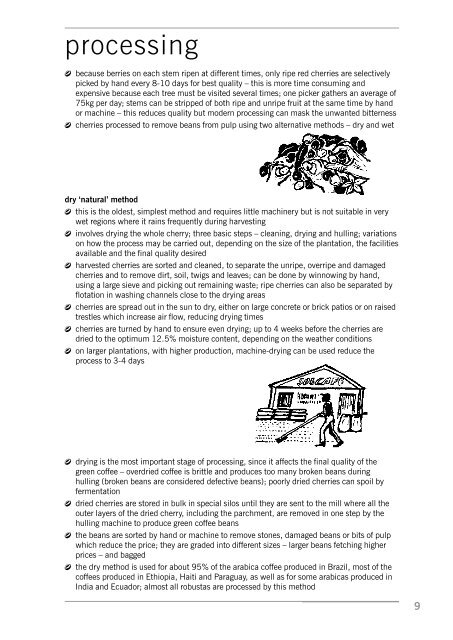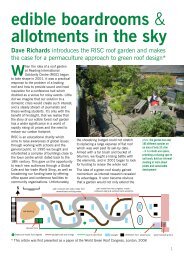Cost of coffee.indd - RISC
Cost of coffee.indd - RISC
Cost of coffee.indd - RISC
You also want an ePaper? Increase the reach of your titles
YUMPU automatically turns print PDFs into web optimized ePapers that Google loves.
processing<br />
D because berries on each stem ripen at different times, only ripe red cherries are selectively<br />
picked by hand every 8-10 days for best quality – this is more time consuming and<br />
expensive because each tree must be visited several times; one picker gathers an average <strong>of</strong><br />
75kg per day; stems can be stripped <strong>of</strong> both ripe and unripe fruit at the same time by hand<br />
or machine – this reduces quality but modern processing can mask the unwanted bitterness<br />
D cherries processed to remove beans from pulp using two alternative methods – dry and wet<br />
dry ‘natural’ method<br />
D this is the oldest, simplest method and requires little machinery but is not suitable in very<br />
wet regions where it rains frequently during harvesting<br />
D involves drying the whole cherry; three basic steps – cleaning, drying and hulling; variations<br />
on how the process may be carried out, depending on the size <strong>of</strong> the plantation, the facilities<br />
available and the final quality desired<br />
D harvested cherries are sorted and cleaned, to separate the unripe, overripe and damaged<br />
cherries and to remove dirt, soil, twigs and leaves; can be done by winnowing by hand,<br />
using a large sieve and picking out remaining waste; ripe cherries can also be separated by<br />
flotation in washing channels close to the drying areas<br />
D cherries are spread out in the sun to dry, either on large concrete or brick patios or on raised<br />
trestles which increase air flow, reducing drying times<br />
D cherries are turned by hand to ensure even drying; up to 4 weeks before the cherries are<br />
dried to the optimum 12.5% moisture content, depending on the weather conditions<br />
D on larger plantations, with higher production, machine-drying can be used reduce the<br />
process to 3-4 days<br />
D drying is the most important stage <strong>of</strong> processing, since it affects the final quality <strong>of</strong> the<br />
green c<strong>of</strong>fee – overdried c<strong>of</strong>fee is brittle and produces too many broken beans during<br />
hulling (broken beans are considered defective beans); poorly dried cherries can spoil by<br />
fermentation<br />
D dried cherries are stored in bulk in special silos until they are sent to the mill where all the<br />
outer layers <strong>of</strong> the dried cherry, including the parchment, are removed in one step by the<br />
hulling machine to produce green c<strong>of</strong>fee beans<br />
D the beans are sorted by hand or machine to remove stones, damaged beans or bits <strong>of</strong> pulp<br />
which reduce the price; they are graded into different sizes – larger beans fetching higher<br />
prices – and bagged<br />
D the dry method is used for about 95% <strong>of</strong> the arabica c<strong>of</strong>fee produced in Brazil, most <strong>of</strong> the<br />
c<strong>of</strong>fees produced in Ethiopia, Haiti and Paraguay, as well as for some arabicas produced in<br />
India and Ecuador; almost all robustas are processed by this method<br />
9




